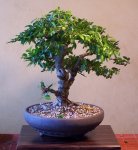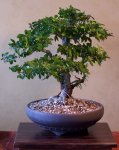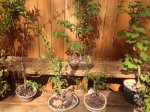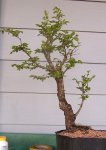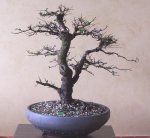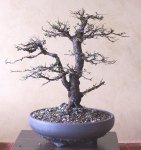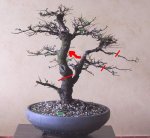Chinese elms are one of my favorite trees, largely because of their small foliage, their hardiness, and their stellar response to Lingnan School clip-and-grow technique, which creates the most natural ramification techniques in all of bonsai.
Let me ask a basic question, if I might: if you don't like Chinese elms in general, and if you only want to put up with one specimen of the sake of rounding out your collection, what was it about this particular tree that appealed to you? I'm sincere in asking this, because it might tell me a lot about where you might want to take this tree.
Ideally, you would put this tree back into a large grow pot or even the ground, until it gave you a better idea where it might want to go and where you might want to go with it; but that might take years, so let's assume you leave it in its current pot.
I like the second image better than the first, and my first impression for both images is that the tree is far too top heavy to look convincing, and that it has far too much foliage, and that the foliage is sitting far too distal from the trunk. It would look better if it was more sparse and more compact, especially at the top.
Next I'd consider some radical Lingnan styling, which, BTW, would also progress much faster over the years if the tree was in a larger grow pot conducive to branch development. Your climate is not as ideal for this technique as the tropics are, but it should be good enough, and trying for rapid year-around growth by bringing it in each winter for a few years may help speed the process along as well.
You can see by the new foliage on the lowest branch that these trees are prone to push new growth on old branches, and this tendency to back bud can be facilitated by heavy pruning. This understanding would be the basis for your Lingnan technique, but either you or other readers may not be familiar with this technique, so let me try to spell it out.
I'd start first by stripping every last leaf off the tree right now, as it is, in its current pot for the moment. This is very easily and quickly done on Chinese elms by simply taking all wire off the tree, and then grabbing each whip one by one at its base with the thumb and index finger of one hand to protect the vital base connection for that whip, and then take the other hand and, starting at the base next to your opposite hand fingers, wrap your thumb, index and middle fingers around the branch securely, and quickly run them out along the whip to its end in one rapid motion, thus stripping every last leaf from that whip. You may even rip away the delicate growing tip of the whip a short ways, but it is completely OK since you will be shortening the whips anyway. This whole process will take about 3-10 minutes max for such a small tree, and some really minor clusters of leaves or isolated leaves should be all that remains, and these can be left on or taken off as well, depending whether growth there is wanted later on.
This will leave you with a growing tree (this time of year), that is bare, as you would see it in winter. This is the start. Now, #1 - you can see the tree's structure much better and make major styling decisions (probably needed); #2 - you can still see the nodes (bud swellings) left on each naked whip, and this will direct your next step.
On each denuded whip you want to keep, look back towards the base of it and decide which direction(s) you might want new growth to go. Then cut the whip off after either the second or third node, making the cut so that it slants out towards that node, which will help direct growth there. Do this for every whip you want to keep. The tree will look very bare at this time.
Fertilize (especially nitrogen) heavily over the next few months as new whips develop from the remaining two or three nodes on each whip, then repeat the process again. In you climate you should be able to do two or maybe three rounds of this each year. This will develop a very pleasing style of ramification under your control over the next few years, and a much more natural look to your branches than you can get with wrapped wiring on this species. Wiring should be confined to guy wires for general branch placement only, although this can also be developed over time with the clip-and-grow technique.
For years now, the only bonsai books I ever look at are some large old beauties from China, often only in Chinese, with page after page after page of the most beautiful trees ever made. Most people who know me well know that I've never liked the stylized images of Japanese trees, but prefer the more natural Chinese aesthetic. If you can find such books, or perhaps such images on line, it would give you some ideas for working with this Chinese elm. These trees are uniquely suited to that sort of styling, and you would probably be inspired to go in a completely different, and much more pleasing direction with this tree.
I hope that helps. Enjoy the tree.

